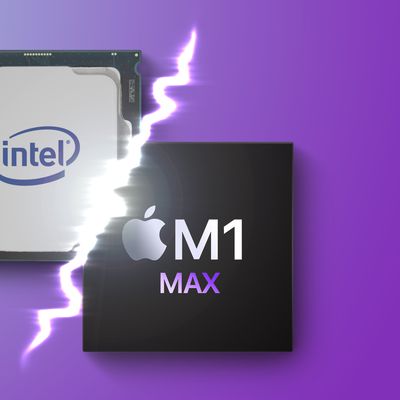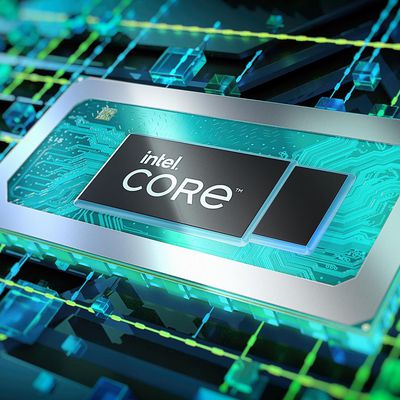Apple in October 2021 introduced its second-generation Apple silicon chips, the M1 Pro and the M1 Max, which follow the M1 and are available in the 14 and 16-inch MacBook Pro models. This guide focuses on the M1 Max, while we have a separate guide for the M1 Pro.
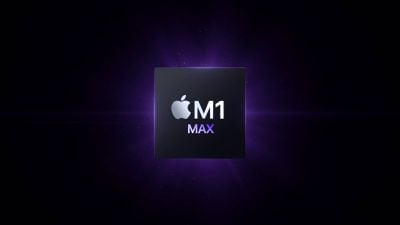
M1 Max Explained
The M1 Max, along with the M1 Pro, is Apple's second System on a Chip (SoC) developed for use in Macs, and it marks Apple's continued transition away from the Intel chips that have been used in Macs since 2006.
As a "System on a Chip," the M1 Max integrates several different components, including the CPU, GPU, unified memory architecture (RAM), Neural Engine, Secure Enclave, SSD controller, image signal processor, encode/decode engines, Thunderbolt controller with USB 4 support, and more, all of which power the different features in the Mac.
Traditional Intel-based Macs used multiple chips for the CPU, GPU, I/O, and security, but integrating multiple components onto one chip allows Apple silicon chips to operate faster and more efficiently than Intel chips.
The M1 Max is equipped with 57 billion transistors and it is built on a 5-nanometer process. It has 70 percent more transistors than the M1 Pro chip and before the M1 Ultra, it was the largest chip that Apple had built to date.
M1 Max vs. Intel Chips
Apple silicon chips like the M1 Max use an Arm-based architecture, similar to the A-series chips that have been used in iPads and iPhones for many years.
Intel chips, meanwhile, are built on x86 architecture, which Apple has decided to move away from. Apple's chips are built by Taiwan Semiconductor Manufacturing Company (TSMC), a company that builds all of Apple's A-series and M-series chips.
CPU
The M1 Max has a 10-core CPU that includes eight high performance cores and two high efficiency cores. According to Apple, the M1 Max's 10-core CPU is up to 70 percent faster than the 8-core CPU in the original M1 chip, which featured four high performance cores and four high efficiency cores.
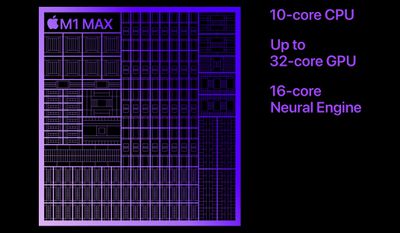
GPU
There are two M1 Max variants, one with a 24-core GPU and one with a 32-core GPU. The 32-core option is the high-end option available in higher-end machines, while the 24-core GPU is exclusively available as a build-to-order option.
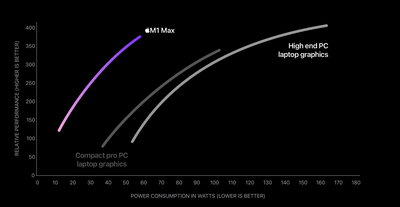
According to Apple, the 32-core M1 Max is up to 4x faster than the original M1 chip. It also delivers performance comparable to a high-end GPU in a compact pro PC laptop while using 100 watts less power. Thanks to this efficiency, the fans run infrequently and quietly, and battery life on the MacBook Pro is longer than ever.
Memory
Apple is using a unified memory architecture that lets the CPU, GPU, and other processor components use the same data pool rather than wasting time copying data between one another and swapping between multiple pools of memory. It's a technique that makes all of Apple's M-series chips remarkably efficient.
With the M1, available memory maxed out at 16GB, but the M1 Max supports up to 64GB. It also offers up to 400GB/s memory bandwidth, 2x more than the M1 Pro and 6x more than the M1.
Media Engine
There's a Media Engine included in the M1 Max that's designed to accelerate video processing without heavily impacting battery life. The M1 Max has the fastest video encoding and is 2x faster than the M1 Pro, plus it has two ProRes accelerators.
The new MacBook Pro with M1 Max can transcode ProRes video up to 10x faster compared to the prior-generation 16-inch MacBook Pro.
Other Chip Features
The M1 Max has several other built-in technologies.
- 16-core Neural Engine for machine learning.
- A display engine that drives external displays.
- Integrated Thunderbolt 4 controllers that offer more I/O bandwidth than before.
- A custom image signal processor used to enhance the camera's image quality.
- Secure Enclave with hardware-verified secure boot and runtime anti-exploitation technology.
M1 Max vs. M1 Pro
The M1 Pro and the M1 Max share the same 10-core CPU (with the exception of the base 8-core Pro chip), but have different graphics capabilities.
The M1 Pro has up to a 16-core GPU, while the M1 Max has up to a 32-core GPU.
We have an in-depth comparison video and guide that walks through the differences between the M1 Max and the M1 Pro, and we also conducted a series of real-world tests to compare performance between the two chips.
Macs With an M1 Pro Chip
The high-end 14-inch MacBook Pro and 16-inch MacBook Pro models released in October 2021 use the M1 Max chips. Lower-end machines are equipped with the M1 Pro.
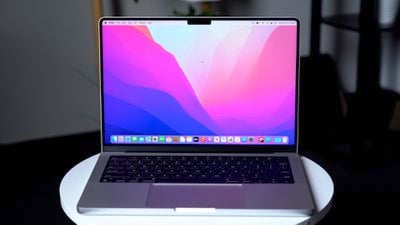
Battery Life Improvements
Apple silicon chips like the M1 Max are more efficient than Intel chips that were used in prior-generation versions of the MacBook Pro, so battery life is way up in the MacBook Pro models that use the M1 Max chips.
The 16-inch MacBook Pro offers up to 21 hours of movie playback and 14 hours of wireless web browsing. The 16-inch Intel machine offered 11 hours of movie playback and 11 hours of wireless web usage.
M1 Max Security Features
Intel Macs had a built-in T2 chip that handled security and other features on the Macs, but with the M-series chips, that functionality is built right in and a secondary chip isn't required.
The M1 Pro has a built-in Secure Enclave that manages Touch ID and a storage controller with AES encryption hardware for SSD performance that's faster and more secure.
Running Apps on the M1 Max
The M-series chips use different architecture than Intel chips, so Apple has designed tools that allow developers to create Universal app binaries that run on both Apple silicon and Intel chips, plus there is a Rosetta 2 translation layer that lets x86 apps operate on machines with Apple silicon.
With Rosetta 2, apps designed for Intel machines will continue to run on M1 Macs with some limited performance compromises. For the most part, apps run similarly on both Intel and Apple silicon because of the performance enhancements added by the M1 Pro and M1 Max chips.
Everything should function as normal when transitioning to Apple silicon Macs, and over the course of a few years, almost all popular Mac apps will be built to run on the M1 Macs natively.
As of now, there's one significant compromise when choosing an Apple silicon Mac, and that's Windows support.
There is no Boot Camp for Macs with Apple silicon chips, and the machines are not officially able to run Windows, although some users are figuring out ways to make it work. Official support could come in the future, but it largely depends on Microsoft licensing its Arm-based version of Windows to consumers, and so far, that hasn't happened.
M1 Pro and M1 Max Macs can run iPhone and iPad apps as well as Mac apps, so long as app developers make them available to Mac users.
M1 Max How Tos
- How to Use Apple Diagnostics to Test Your Mac
- How to Tell Which Apps Are Optimized for Apple Silicon Macs
- How to Transfer Files Between an Apple Silicon Mac and Another Mac
- How to Reinstall macOS on an Apple Silicon Mac
- How to Install Rosetta on Your Apple Silicon Mac
- How to Start Up in Safe Mode on an Apple Silicon Mac
- How to Install iPhone or iPad Apps on an Apple Silicon Mac
- How to Repair the Startup Disk on Apple Silicon Macs
- How to Turn Off Optimized Battery Charging in macOS
- How to Check the Battery Health of Your Apple Silicon MacBook
- How to Launch the Intel Version of a Universal Apple Silicon App
Guide Feedback
Have questions about the M1 Max chip, know of a feature we left out, or want to offer feedback on this guide? Send us an email here.


